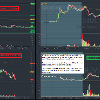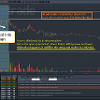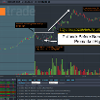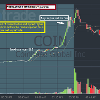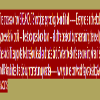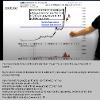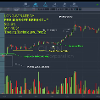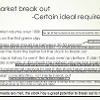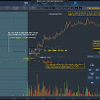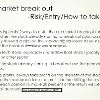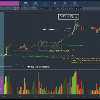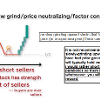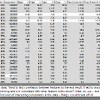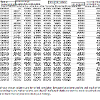PREMARKET---------
Not even Sykes nor Bohen nor other millionaire traders trade PREMARKET due to it's risk, so.
(i am typically not awake and alert at this point.stock's move quickly / highly volatile at market open where it matters most / my stats show i perform poorly in premarket, generally speaking).
Too risky to play due to LARGE DROPS IN PRICE, THUS MAKING IT HARD TO CALL THE BOTTOM ON A DIP BUY, ESPECIALLY if the stock is having an OFFERING. I am not adept to reading SEC filings to the extent of researching and identifying SEC Filings disclosing OFFERING/Dilution/ATM/Financing information.
- >5% gainer and <100% gain (you don't want the stock to be over-extended).
- news catalyst (ideally: merger news; earnings winner; contract winner; funding news)
- premarket volume (at least 100k; or trading >10x more than it's AVG 60-day VOLUME).
- ≥2x float rotation (means buyers are willing to pay any price; i.e. there is interest).
- low float (less than <10m float | the lower the float, the better) <---VERY IMPORTANT
- focus on MULTI-DAY RUNNER stocks (for premarket squeezes/spikes; why? there's PROOF that these stocks can spike big again and soon). A stock can run for days but usually fails once!
- the stock should be a former runner (spiked over 100% within past year).
- <100m market cap (the lower the better; >200m makes it harder for stock to spike >60%) <----VERY IMPORTANT
- no heavy resistance (less than <20m volume at historic resistance levels, going 6-months back)...if there's heavy resistance, SELL before the stock reaches/hits the heavy resistance level.
- clean chart (no 3-5 year hard resistance nearby the breakout level).
- hot sector (or is a SYMPATHY play/part of a hot market theme; a BIOTECH is great)
- it is MONDAY (or if its FRIDAY, short-squeeze spikes are liable to occur as well).
- the stock must have decent CONSOLIDATION in premarket for it to work <---VERY IMPORTANT [Min 1:13:30 - Part 4 - Trading Techniques DVD].
- if the stock GAPPED UP, make sure there are no ⚠️ WARRANTS, OFFERINGS, DILUTION (if there is, the breakout is likely to fail❌) [Min 1:13:40 - Part 4 - Trading Techniques DVD] <----VERY IMPORTANT
If you don't know where the top of a spike's going to be, always sell into the premarket high. -Dux
33% sizing in at pre-market high breakout;33% after the stock pulls back to hold 1/2 of its own spike (at a double-bottom);33% sizing in after the stock breaks out again above it's most recent highs.SELL INTO STRENGTH THEN!
if a stock spikes pre-market, it likely won't spike at market open.
Then as more traders come in, buying on the press release, you get a [dip and rip]… Or, if it dies it dies. -Bohen #premarket #chatpumps #Dip&Rip
A premarket breakout pattern can be a pattern that appears on a FIRST GREEN DAY chart. -[Dux commentary]
ROLAND: Premarket is very important because that's when new news is being released.
SYKES: i use pre-market as a guide to find %gainers and new news.
Stocks with the highest volume tend to be subject to manipulation (meaning they can spike more).. if a stock trades a lot of volume pre-market, then during the day it will trade a ton of volume likely.. if there's no volume, ignore because if you get in it'll be hard to get out. -brian lee
if the stock is up pre-market, i put it on my watchlist...No matter what the news is, the STOCK'S REACTION is what determines if the news is significant. If the stock has good news and goes up 10-20% , not everybody will catch it on day 1, so on day 2 and day 3 it can run-up even more as the publicity of the news travels. -Sykes
Just because a stock doesn’t look like a good potential trade in premarket, you have to stay open-minded to opportunities as the day unfolds. Anything can happen in the market — breaking news can be released mid-day, volume can increase as the day goes on, and patterns can emerge... Price action dictates everything... -Bohen
PRE-MARKET spikes almost always pull back hard. . . . Trading in pre-market will work here and there. . but it's not the path of consistency. . .
If a stock can hold it's pre-market gains ALL DAY, that means the stock has extra strength... so long-term bagholders are actually sold and there's enough dip-buyers to push the stock to close very strong (relative to the OPEN).. and that's a very bullish signal/factor... -Dux
Look for stocks that spike and pull back in premarket. Or stocks that spike and consolidate... Then watch for breakouts above the premarket high. Notice Oracle resistance areas, and be out of your trade by 10 AM; most stocks slow down after 10 AM. Then come back in the afternoon (after 1 pm) for more opportunities to trade the same stock.
I'm not a fan of premarket, because there's many gappers but few actually spike up. -Tuohey
Min 39:55 - Min 43 --------- The process of how BREAKOUTS work (the psychology behind them) ------- Everyone is in the stock for the breakout -- the breakout POPS UP --- everyone sells for profit --- the stock goes back down --- all of the breakout buyers remaining then sell (that 90% lose) ---- then Roland comes in and buys the stock if it supports the breakout level (and that's kind of when the short's are covering when it isn't cracking; they cover their shares (they buy back in), and Roland rides the dip-buy momentum upwards) ------- www.youtube.com/watch?app=desktop&v=XY76jXe-Fk4 ....... [WHY BREAKOUTS ARE CHOPPY] #BREAKOUTS
A key function Grittani uses for the stats he tracks is CONDITIONAL FORMATTING... (i.e. to see if an afternoon breakout is a good pattern to trade, he does the following with the data he's collected) : 1. what was the HOD minus the breakout point divided by the breakout (decimal $ amount) -- this will tell me WHAT PERCENT IT RAN FROM BREAKOUT TO HOD... that number will be ideally 15% or 20%....2. Then use CONDITIONAL FORMATTING, to highlight the 15% or 20% occurrences amidst all of the data cells.... helping it to visually stand out, the ones that were successful (at a 15% / 20% occurrence)....3. Then i will take other columns and sort them highest to lowest (i.e. market cap).... then i will look for clusters (ideally the best percentage runners of the breakout showing in the lower market cap, we'll say for this example... and fewer ones displaying (big % runners) at the higher market caps....4. Then this will tell me to begin ignoring bigger market caps when playing afternoon breakouts, for instance... This has produced good results for me #Grittani -------- Min 22:15 --------- www.youtube.com/watch?v=5PP63Z2Bu-4&t=2s .... [details: https://exceljet.net/conditional-formatting-formulas]
-------Premarket scanning is essential .... awake at 8 am and scan.... find out if the stock is Gapping up based on news (news is a great catalyst). does it have substantial Volume?..
- >$100,000 in dollar volume ($volume)
- >500,000 volume in premarket (the more volume the better)
- low priced (<$15 or under)
- stock gain: >12%+ [stocks up at least 12%]
- then I pull up the daily chart, and go from there.
- Pre-market volume: >100,000 (greater than 100k volume; or at least 50,000)
- Pre-market %Gain: >20%
- Has a catalyst (strong news)
- Buy signal: when the stock breaks it's pre-market highs.
- A market cap under 100M will be good when considering to buy a pre-market breakout.. If it is around 200m it is then hard for the stock to spike even 60%. -Dux
TRACKING STATS ------ Min 51:20----Min 1:12:45 ----- PART 4 ---- TRADING TECHNIQUES ....
- What is the stock's float?
- what is the stock's market cap?
- TRACK:
- Does the stock have good news?
- How has the stock reacted to good news historically? (explain the consistent next 5-10 day candles following the stock's supernova/spiking)
- how many pre-market pullbacks does the stock have?
- did the stock hold HALF IT'S SPIKE/GAINS when it pulled back?
- what is the stock's volume?
- has the pattern i'm considering trading pre-market, been working in the overall market?
- did the stock GAP UP in premarket?
- did the stock reclaim it's premarket highs at 9:45 am?
- did the stock BREAKOUT after it tested it's premarket highs resistance, at 9:45 am?
- was it a MONDAY when the stock GAPPED UP?
- did the stock hold above it's PREVIOUS BREAKOUT levels (on the past Friday) during MONDAY MORNING'S GAP UP? <---if yes, this is something to look out for when judging a stock's potential to SPIKE BIG / GAP UP BIG during PREMARKET ON MONDAY.
- if the stock did GAP UP ON MONDAY, did the stock consolidate with volume on the previous Fridays based on the stock's being up from a First Green Day a couple of days earlier (on Monday/Tuesday/Wednesday of that week)? <---if yes, this is something to look out for when judging a stock's potential to SPIKE BIG / GAP UP BIG during PREMARKET ON MONDAY.
- what was the FLOAT ROTATION? A stock can have only so many float rotations (only so many maximum number of times) before it drops back down in price.
- did the company announce an OFFERING / DILUTION / WARRANTS? (if yes, the premarket breakout is likely to fail❌).
- the stock's previous day's open price?
- for stocks that spiked during pre-market, did the stock also spike at market open? (if a stock spikes pre-market, it likely won't spike at market open).
- is the stock a 100%+ gainer (less than <100% gainers = better)?
- what was the stock's TOP TICK %?
- what was the stock's LOW TICK %?
- is it MONDAY morning? (Monday mornings(premarket) tends to be a volatile period).
- is it FRIDAY morning? (Friday's are short-squeeze days).
- did the stock hold it's PREMARKET GAINS all day? (this is a very bullish factor)
- what was the premarket volume when i traded it?
- what was the premarket volume by the time the stock market opened at 9:30 am?
- is the stock a SYMPATHY play (in a hot sector / part of a hot market theme)?
- what is the widest time-frame the breakout spiked above (6 month highs? 3-month highs? 1-year highs? 3-year highs?)
- how is the overall $IXIC and $SPY and $DJI exchanges performing?
- did the stock's trend in premarket continue with how the stock trended after the market open? <----------Uptrending price action in pre-market will often have strong price action once the market opens. If a stocking gapping up is fading off hard in pre-market, it is likely it will continue to fade off when the market opens. Sometimes there will be 'no trend' during pre-market, thus wait to see how the stock trends at the market open.
- did the stock spike based on a trading halt?
- did the PREMARKET VOLUME exceed the stock's [60-day average volume]?
- after the stock SPIKED in premarket, how many pullbacks did it have before spiking again (what was it's formation: did it spike, consolidate, tank? spike, consolidate, spike?) --- [Min 52 - Part 4 - Trading Techniques DVD].
- how much did the PREMARKET VOLUME exceed the stock's [60-day average volume]? (by 10x, 50x, 100x)?
- what was the stock's previous day's closing price?
- what is the stock's previous day's pre-market high?
- what was the stock's previous day's high tick/price?
- what was the stock's previous day's lowest tick/price?
- what is the stock's average 10-day volume?
- is there heavy resistance for the stock in the past 6 months, at the resistance levels, of more than 10m volume? more than 20m volume? more than 30m volume?
- what was the stock's news catalyst?
- If the stock was a PREMARKET BREAKOUT on MONDAY MORNING (anytime between 4 am - 9:30 am), had it END THE PREVIOUS FRIDAY NEAR ITS HIGHS?
- was the stock uptrending in the past 6-months?
- was the stock uptrending in the past 3-months?
- was the stock uptrending in the past 1-month?
- was the stock uptrending in the past 1-year?
- did the stock rid of all of its BAGHOLDERS when it gapped/spiked? [Min 20:40 | Min 30:30 | Min 36 - Min 40 | Min 50 | Min 58 -- https://youtu.be/zvs_8zF-i1E]
- was the premarket breakout due to it being a CHAT PUMP?
- did the stock TANK at the open after it spiked in PREMARKET?
- did the stock open at 9:30 am, ABOVE or BELOW "vwap"?
- if the stock was a CHAT PUMP, did it eventually formulate into a DIP AND RIP?
- did the premarket breakout eventually formulate into an AFTERNOON VWAP HOLD?
- did the DIP AND RIP PATTERN that was also a PREMARKET CHAT PUMP, end up formulating into a AFTERNOON VWAP HOLD?
- what is the SPY's performance on the day (green on the day = bullish). 3 out of 4 stocks follow the $SPY and DOW JONES stock trends.
- at market open, did the stock open near / above its pre-market highs? (if yes, this is a good sign to long the stock #dip&rip or b/o pattern)
- At the market open, did the stock fade into the open, drifting lower and lower as the day went on? (if so, this nullifies the setup and makes it a NO-GO).
- was the stock under vwap or above vwap throughout the majority of the day (after market open)?
- did the stock CONSOLIDATE over a period of time, as the market open (9:30 am) was approaching? <-----I DON'T KNOW IF THIS IS A FACTOR OR NOT THAT REQUIRES HEEDING, BUT NOTATE IT ANYWAYS TO SEE IF THERE'S ANY SORT OF TREND OR PATTERN WITH STOCKS THAT PERFORM THE PATTERN WELL THAT ALSO CONSOLIDATE IN PRE-MARKET.
- is the stock a multi-day runner? <-----I DON'T KNOW IF THIS IS A FACTOR OR NOT THAT REQUIRES HEEDING, BUT NOTATE IT ANYWAYS TO SEE IF THERE'S ANY SORT OF TREND OR PATTERN WITH STOCKS THAT PERFORM THE PATTERN WELL THAT ALSO CONSOLIDATE IN PRE-MARKET.
- if the stock had a big premarket spike, that was based on news, and was also a chat pump, did it fail at the open and fade all day? ★nine out of 10 chat pumps★ fail at the open. But that one out of 10 time, it can short-squeeze.
- Track for short-selling: stocks that spiked yesterday, but are now DOWN -11% or more in premarket -- how does the stock continue playing out? INSIGHT TO TEST: if a stock spiked yesterday, and is now down in pre-market (by -11%+ or more), then that is a bearish sign that it could be the end of the stock's spiking. -[Sykes commentary]
- Track volume statistics: stocks that performed the best in pre-market (were the biggest spikers): what was the volume for those stocks? (find all stocks that spiked great in pre-market, and calculate the average volume they all traded), and the average %Gain each had based on it's volume traded. INSIGHT TO TEST: IF there is LIGHT VOLUME (less than 5 million volume) in pre market, that automatically makes the trade a post 9:45 am idea (in other words, never trade at the open or during pre market if there is LOW VOLUME of less than <5 million volume). -[Bohen commentary]
- Track float statistics: stocks that performed the best in pre-market (were the biggest spikers): what was the float for those stocks? (find all stocks that spiked great in pre-market, and calculate the average float they all traded), and the average %Gain/SPIKE% each had based on it's float. INSIGHT TO TEST: The premarket breakout only works on LOW FLOATS and SMALL MARKET CAPS (doesn't work very well on LARGE CAP STOCKS). -Dux
- Track market cap statistics: stocks that performed the best in pre-market (were the biggest spikers): what was the market cap for those stocks? (find all stocks that spiked great in pre-market, and calculate the average market cap they all traded), and the average %Gain/SPIKE% each had based on it's market cap. INSIGHT TO TEST: The premarket breakout only works on LOW FLOATS and SMALL MARKET CAPS (doesn't work very well on LARGE CAP STOCKS). -Dux
- Track volume support candles: did the stock have a massive green support candle (prior to the breakout that occurred?) INSIGHT TO TEST: when a stock has massive green-candle VOLUME SUPPORT at it's previous support levels, it is a very bullish factor. -Dux ......... The larger the support volume at the stock's support price-point (currently / present-day), the easier the SUPPORT LEVEL will hold... The current day volume needs to be higher than the previous support in order to hold. -Dux
- Did the stock hold near the resistance/at resistance levels for 5-15 minutes? (if so, the stock has a chance at breaking out above resistance; good buyer volume).
- Did the stock hit resistance and quickly fall away/fade from resistance levels (if so, the trade is a no-go; i.e. not enough buyer volume).
- Did the stock hold VWAP after it pulled back from resistance levels? (when the stock holds VWAP, even off a pullback from the highs, that can give bulls strength to breakout).
- When tracking VOLUME, always track both of these:::::: [VOLUME in premarket] and [VOLUME end of day].......
- What was the stock's OPEN price?
- What was the stock's CLOSE price?
- What was the stock's HIGH TICK price?
- What was the stock's LOW TICK price?
TRACK THE ACCURACY OF THIS METHODOLOGY
how to predict volume for a stock (its total for the day):
1] Multiply the volume by 10 (10x) during pre-market [prior to 9:30 am]2] or, during the first hour of the market, multiply that volume by 4 (4x)
- is the stock a former supernova? does it have a history of spikes and/or breakouts?
- how much did the stock's volume increase during it's past breakouts?
- what time of day was the breakout?
- how many times did the stock test PREVIOUS HIGHS before breaking out?
SHORTING A PREMARKET BREAKOUT: the over-extended gap-down strategy is a good strategy to play after a pre-market breakout occurs... You play the over-extended gap down on day 2 or day 3 of the stock's spiking (after it's first green day).... Min 49:10 on PART 2 ORIGINAL.
I ALREADY WATCHED EVERYTHING BELOW!
★ PLAYING AFTERNOON VWAP HOLD PLAYS IS ALWAYS THE BEST DECISION WHEN LOTS OF STOCKS ARE SPIKING LARGE PERCENT GAINS IN THE MORNING (AND OVERALL, MULTI-DAY RUNNERS ARE MUCH BETTER TO PLAY THAN PREMARKET BREAKOUTS (NEVER TRADE PREMARKET; IF YOU DO TRADE PREMARKET, "BUY IN PRE, SELL IN PRE" is the saying) because a stock can tank at the open after it's spiked in premarket
⇾ With all the gappers in premarket yesterday, a lot of traders got excited.
⇾ a lot of traders struggle with FOMO. They want to nail every play and make bank, Bro…
⇾ So they bounce all over the place, chase entries in the wrong tickers, then end up with a loss and wasted capital.
⇾ Here’s what I prefer to do...
⇾ I wait until the afternoon — at least noon or later.
⇾ Because when you let the charts play out, it makes it easier to spot the one lone survivor. -Bohen
Because "buy in pre, sell in pre" and the [dip and rip] are complementary patterns when it comes to trading [chat pumps].
Here’s why…
When a ‘guru’ sends out their alert to chat followers, the stock spikes in PREMARKET. But when the market opens, it will pull back as the ‘guru’ sells and premarket traders take profits…
Then as more traders come in, buying on the press release, you get a [dip and rip]… Or, if it dies it dies. -Bohen #premarket #chatpumps #Dip&Rip
-very wide bid/ask spreads (tough to get a fill at the price you seek)-tough executions (lack of volume)
-not a lot of volatility (lack of volume)
❥Former runner
❥Breaking news
❥Low float
❥Hot sector
❥High volume
Whenever dealing with morning trades, especially stocks with higher floats, I need the stock to tell me it wants to go higher. The only way it does this is by breaking & holding an important level. -Bohen
Which would you rather trade: A premarket squeezer: on the 1st day, or as a multi-day runner?
My money’s always on the multi-day runner.
Why?
Because multi-day runners have something these fly-by-night stocks don’t … PROOF!
let me tell you a little secret … A stock can run for days but usually fails once!
That’s a big reason why I don’t like the sketchy biotechs that pop on news.
I prefer stocks that show me over a series of days, if not weeks, that they want to move higher.
Many traders struggle to find these stocks for two reasons:
- Multi-day runners have news that dropped before the current trading day
- Traders miss the trend reversal
The rules for premarket trading aren’t the same as they are for regular hours.
You need to look at the premarket and regular session almost as if they’re two different days.
My advice? Buy in pre, sell in pre [exit premarket positions by 9:30 am].
For starters, you can’t do market orders [only LIMIT ORDERS].
But more importantly, trading volume in the premarket is typically lighter than the regular session.
That’s why I like to look for stocks with HEAVY PREMARKET VOLUME.
➜When you see profit, take it.
•good news
•heavy volume
•multi-month / multi-year breakout -bohen
Watch multiple stocks for potential dip and rips, weak open red-to-green moves, breaks above the previous day’s high, and chat pumps [for chat pumps, the safe play was to wait until 9:45 a.m. or later]….
Buy in Pre, Sell in Pre --------- Anytime you trade a chat pump in premarket and you get a $1 to $2 rip before the open and you take profits… That’s how you trade a chat pump.
I don't care if [the stock] would’ve gone to $30 after they sold. It’s not worth the risk to hold a chat pump through the market open… Because nine out of 10 times they fail. Don't overstay and watch the stock sink like a stone at the market open (turning your winner into a loser)… And the one time out of ten that a chat pump doesn’t fail at the open — you can always get back in. -Bohen #chatPumps #pumpanddumps #pump&dumps
With any trade that breaks a premarket high, we always risk a fakeout.
More often than not, shares will poke through the high and then quickly fall away.
That’s why the timing component is so crucial here.
It’s what made the difference.
Every time a stock runs up into a resistance level, give it 5-15 minutes to tell you which way it wants to go.
If shares spike through and quickly fall away, you know the morning trade is a no-go.
If shares hold near that level for 15 minutes and VWAP starts to creep up, now you’ve got a shot at pushing higher.
It’s also important to analyze the volume.
Higher volume means more conviction. When a stock makes a high-volume tail candle at the premarket highs, it will have a heck of a time trying to break through again.
Also, keep an eye on VWAP.
I’m not a fan of premarket trading.
Quite simply, I don’t think the reward justifies the risk.
That said, premarkets aren’t void of opportunities, you just have to know HOW to play them.
I normally shy away from PREMARKET chat pumps.
30-minute marks in premarket are important. We see that all the time with stocks flying on 8:30 a.m. news reports.
9:00 a.m. is also a critical time.
That’s when traders start to plan their day.
Making a 10% - 15% gain in premarket is about the max you can get in premarket or should at least try to.
However, the price action at the open can quickly spike stops and leave you with nothing.
That’s why I strongly recommend ‘buy-in pre, sell in pre.’
One of the biggest mistakes traders make is failing to lock in profits.
Trading in premarket is tricky and takes practice.
Don’t let those initial pushes make you feel like you’re missing out on the action.
If you don’t consistently make money trading in premarket, stop doing it.
You won’t get better by losing money.
Focus on trading the regular session when the odds are in your favor. -Bohen #premarket
Min 13 (pre-market watching; I might have 15 or 20 stocks on the watchlist but I'll be actively watching to pull the trigger on 2 or 4 stocks) ------ Min 15 (pre-market trading; tips for shorting) ----- Min 21-27 (focus on 1 or 2 tickers to play; 80% of your profits will come from 20% of your plays) ------- Min 29 - end (the benefits of using alerts) ---------- https://m.youtube.com/watch?v=Yj0gH6YyUHM ......... #BTheStory #NateMichaud
A premarket breakout pattern can be a pattern that appears on a FIRST GREEN DAY chart... -[Dux commentary]
If you're longing, pre-market planning in the
morning is very important because that's when new news is being released....
-[ROLAND commentary]
Grittani's PRE-MARKET
SCAN (circa 2015, so
some of these # may need to get adjusted, such as volume/dollar volume
especially (which Monaco for instance scans for $1m of dollar vol.)
·
at least $100k in volume (dollar volume)
·
lower priced ($15 or under)
·
stocks that are gapping up (at least 20% up)
·
then I pull up the daily chart, and go from there...
Min 12:50(pre-market
watchlist; I might have 15 or 20
stocks on my watchlist, but I'll actively watch to trade 2 or 4 stocks) ------ Min 15 (pre-market
trading; tips for shorting) ----- Min 21-27 (focus on 1
or 2 tickers only; 80% of your profits will come from 20% of your
plays) ------- Min 29 - end (the
benefits of using alerts) ---------- https://m.youtube.com/watch?v=Yj0gH6YyUHM .........
#BTheStory #NateMichaud
PRE-MARKET VOLUME -------- Min 33
----------- pre-market volume is important to gauge (evaluate how the volume impacts how it's traded in the past)...
stocks with the highest volume tend to be the most crowded and subject to
manipulation (meaning they can spike more) ---if a stock trades a lot of volume
pre-market then during the day it will trade a ton of volume
likely ---------- if there's no volume at all, ignore because if you get
in it'll be hard to get out ------ www.youtube.com/watch?v=Is_L18QDg9Y
............. #BrianLee
If a stock is trading more than 5m volume or 10m+ volume during PREMARKET, that is kind of abnormal and suggests that during the day it's going to trade a ton of volume. -Brian Lee
Min 5:50 -------- Scanning for large
cap/small cap gappers in pre-market ---------- www.youtube.com/watch?v=Kc1BqinZ994
........ #kunal #bthestory #scanning
When you see the pre-market volume, you can estimate the entire day's volume..... [Whatever the volume is during pre-market, multiply it by 10 (10x) and that gives you the average prediction for the volume throughout the day..... [If no volume during the pre-market, at the open, after the first hour, multiply that first hr volume by 4x to get the day's volume....... this helps out a ton especially when you're shorting a resistance play and you're using a previous day's volume (you don't want it to be overwhelming volume compared to that volume which you're using as resistance, b/c then there's a higher chance it's not going to work)..... this is how it's helped me, i know it can help you too....... A heavily volume traded stock is anything trading over 25M... 5M = light resistance | 20M = Mid resistance | 30M = Large resistance | 40M = Heavy resistance...... -Dux
1] Multiply the volume by 10 (10x) during pre-market [prior to 9:30 am]
2] or, during the first hour of the market, multiply that volume by 4 (4x)
I'm more likely to buy morning spikes, on Fridays......-Sykes
MONDAY gap-ups are notoriously known for being very good in spiking (when consolidation with volume happens on Fridays based on a stock's being up from a First Green Day a couple of days prior at the least), so long as it holds on Monday morning over the previous Breakout level. . . -[Marianna commentary] #mondays
If the market cap
is around 200m, it is hard for the stock to spike about 60% or 100%.... A
market cap under 100M will be good when considering to buy a pre-market
breakout.. If it is around 200m it is then hard for the stock to spike even
60%... -Dux
I
trade pre-market if the stock has great news in the early morning....Otherwise
i don't trade pre-market -- the price action can be very wrong/ misleading.. if
the stock is up pre-market, i put it on my watchlist...No matter what the news is,
the STOCK'S REACTION is what determines if the news is significant. If a stock
does spike in reaction to earnings, that's an "earning's winner"; the
same for a "contract winner"..... [Sometimes good news is already
included in the stock's price action].... If the stock has good news and goes
up 10-20% , not everybody will catch it on day 1, so on day 2 and day 3 it can
run-up even more as the publicity of the news travels..... #Sykes
MONDAY gap-ups are notoriously known for being very good in spiking (when consolidation with volume happens on Fridays based on a stock's being up from a First Green Day a couple of days prior at the least), so long as it holds on Monday morning over the previous Breakout level. . . -[Marianna commentary] #mondays
If the market cap is around 200m, it is hard for the stock to spike about 60% or 100%.... A market cap under 100M will be good when considering to buy a pre-market breakout.. If it is around 200m it is then hard for the stock to spike even 60%... -Dux
Very rarely will I trade
pre-market or after-hours because those times are very illiquid...... many
stocks will trade pre-market, but i use pre-market as a guide to find %gainers
and new news......
PREMARKET trading
usually has light volume / little liquidity... the stock might be up or down a
little bit and some people are just trying to get a head-start... even if the
stock is up pre-market that doesn't mean it'll be up when the market
opens...however i have bought pre-market in the past when there's extraordinary
news if I think the stock will shoot up when the market opens...
AFTER-HOURS trading is
very limited (based on any news that is being released after-hours);
after-hours winners are mainly EARNINGS winners or investor or big news
contracts that are announced after-hours.... but very rarely i will trade it
unless the news is very amazing...... i just use after-hours to look for big %
gainers, for stocks that will be in play tomorrow.... -Sykes
Rules For Trading Premarket Runners ----------- Buy In Pre, Sell In
Pre:::: If you take a position in a premarket spiker, I always say buy in pre,
sell in pre. If you have profits, lock them in before the market opens. Because
that’s when you can get choppy price action. It doesn’t matter if the stock
goes up more after the open. Take profits doing safe trades (selling for profit
in pre-market). And you can always get back in. -Bohen #premarket #plays #pre-market
I don't like trading the
open... I'm generally going to give a stock at least 5 minutes, to see where
the action goes... The market opens, and i wait... That's what i do... Volume
is very important -- so if i can let the stock shake out a little bit, the
volume levels will reveal themselves... It's very hard to find solid risk
levels at market open (unless you're using pre-market action or arbitrary numbers).. but if you give a stock 5-15 minutes after market open, the
support level will reveal itself, as will risk/reward... -Roland Wolf
[www.youtube.com/watch?v=cE3P8mtSyx4] #PLAYS
#MARKETOPEN
----------Premarket scanning is essential ........
awake at 8 am and scan...... find out if the stock is Gapping up based on news
(news is a great catalyst)........ does it have substantial Volume? ........
If I see a low-float
stock (10 million float) trading 20 million volume in
premarket — it has 2X float rotation. That’s what I like to see…
There are plenty of
stocks that can rotate their float throughout the day. But seeing that kind of
volume in premarket shows me that traders are interested ... Like all eyes are
on this one ticker.
The tickers that trade the most VOLUME are the ones that end up running/spiking large percentages. -Alex Salf
Just because a stock doesn’t look like a good potential trade in
premarket, you have to stay open-minded to opportunities as the day unfolds.
Anything can happen in the market — breaking news can be released mid-day,
volume can increase as the day goes on, and patterns can emerge. ... Price
action dictates everything... -Bohen #PLAYS
Before you buy a premarket runner, ask yourself if
the pattern your trading has been working. Or if the stock has news, has it
been a good catalyst in the current market? Is the stock part of
a hot market theme? -Bohen
Stick to day trades only. Companies usually announce
offerings in premarket or after hours. Those are illiquid trading times when it
can be tough to exit positions quickly. So avoid trading during these times
and… -Bohen #dilution #offerings #financing
Morning spikes occur more on Fridays.... Spikes occur
more on Fridays because short-sellers are scared on Fridays.....
they don't want to hold positions on Fridays... They’d rather exit positions so
that they don't have to think about what could happen over the weekend...
--------pre-market spikes seem to replace morning spikes after the market opens...... (if a stock spikes pre-market, it likely won't spike at market open).........
A stock’s pre-market trend will be a strong indicator of how the stock will behave once the market opens. Uptrending price action in pre-market will often have strong price action once the market opens. If a stocking gapping up is fading off hard in pre-market, it is likely it will continue to fade off when the market opens..... Don’t fight strong pre-market trends. If there is no obvious pre-market trend, wait to see how the stock behaves when the market opens, and join the trend versus trying to guess which way the stock will go.
Min 14 --------- min 18 --------- pre-market trading is difficult -------- Dan Irish doesn't do
it, it's too much for him | trends are tough to read in premarket when there isn't volume --------- www.youtube.com/watch?v=QU1bBmRyKn0 ........... #DanIrish #premarket
ESSENTIAL ======== I know people like Bohen refuse to buy any stocks
in the first 15 minutes of the day. And I know some people love buying stocks at the beginning of the day or premarket, and then they’re done for the
rest of the day. So try different things and see what works over and over.
QUESTION: how do you trade pre-market, or after-market closers?
ANSWER: you got to have the right broker. . . . if you don't
understand how to trade pre-market or after-hours, you shouldn't be doing it. .
. Pre-market is crazy. After-hours is totally wonky. . crazy moves all over the
place. If you're new, avoid after-hours like the plague. And try to avoid pre-market. If you're new, avoid the
wild wild west. . . -Tim Bohen
STRATEGY ---------- Low float, big % gainer (with news) will spike through the high of day when the price
reclaims pre-market highs at around 9:45 am............ [at 9:45 am, look
for stocks that are reclaiming their pre-market highs]........... -Tim Bohen
QUESTION: What do I use as an indicator to determine unusual volume?
ANSWER: The 60-day Average Volume. . . . . Every stock, every day, I look at
that. I want to know what is it doing in pre-market, and does it have the
potential to exceed that AVERAGE 60-day VOLUME by 10x, 50x, 100x. . .
WHETHER OR NOT YOU SHOULD BE TRADING, if the stock you're looking at:
- In Pre-Market, isn't trading 50k shares minimum. . . . IGNORE
IT. . .
- After 9:30 open, isn't trading 1million shares. . . IGNORE IT. .
.
* say the stock is trading 1M shares at the open, but if the AVG Volume is
15M shares, it's not going to be unusual volume. . .IGNORE IT. . . . .
Recognize unusual volume, and ignore low-volume stocks.
PRE-MARKET STOCKS TO PLAY
- Low float stock (less than 10 million shares [in pre-market])
- Big gainer (greater than 20% [in pre-market])
- Real Volume (1 Million shares or more [in pre-market])
- News (the news doesn't need to be that great; any news in LOW FLOAT
stocks will bring buyers)
- Spiked [in pre-market]
PRE-MARKET spikes almost always pull back hard. . . . Trading in pre-market will work here and there. . but it's not the path of consistency. . .
* volume during pre-market and after-hours is generally low volume. .
. These are riskier times to be trading and better times to be planning
your trades for the upcoming day.
I don't really like to trade pre-market.... (it's) for the degenerate
gamblers..... But i use pre-market levels as a guide... -Sykes
Sykes doesn't trade pre-market.... he uses it as a guide to find percent
gainers and new news........
PREMARKET TRADING DOWNSIDES [Pre-market trading is not
advised/recommended/best]
-very wide bid/ask spreads (tough to get a fill at the price you seek)
-tough executions (lack of volume)
-not a lot of volatility (lack of volume) -GRITTANI
OTCs start pre-market trading at 8
am.
Listed(Nasdaq) stocks start pre-market trading at 4 am (8am
is when things pick up)
ADD TO MY PRE-MARKET SECTION THE WHOLE SECTION AND
IMAGES OF GRAPHS FOUND IN DUX’S DVD WEBPAGE I CREATED -------- https://qintarcapital.com/trading-techniques.php ............<----------I ALREADY DID THIS!
If you don't know where the top of a spike is going
to be, always sell into the pre-market high (check the top tick in the
pre-market and sell there)... -Dux commentary
In the pre-market, anything that is over 100% and starts gapping and
holding -- that's called a GAP FILL strategy (b/c it closed above the open). -Dux
If a stock can hold it's pre-market gains ALL DAY, that means the stock
has extra strength... so long-term bagholders are actually sold and there's
enough dip-buyers to push the stock to close very strong (relative to the
OPEN).. and that's a very bullish signal/factor... -Dux
SHORTING A PREMARKET BREAKOUT: the over-extended gap-down strategy is a good strategy to play after a pre-market breakout occurs... You play the over-extended gap down on day 2 or day 3 of the stock's spiking (after it's first green day).... Min 49:10 on PART 2 ORIGINAL.
Look for stocks that spike and pull back in premarket. Or stocks that spike and consolidate... Then watch for breakouts above the premarket high or consolidation area. Notice Oracle resistance areas, and be out of your trade by 10 AM; most stocks slow down after 10 AM. Then come back in the afternoon (after 1 pm) for more opportunities to trade the same stock.
Min 1:40 --------- the importance of VWAP::::: anytime a stock opens up under VWAP, be wary of it; VWAP works as heavy resistance anytime a stock is beneath it ------ www.youtube.com/watch?v=I'm not a big fan of trading pre-market trading, because there are so many gappers but so few of them actually end up spiking up. -Tuohey
TRACKING STATS: Min 51:20 AND Min 1:12:45 of PART 4 of TRADING TECHNIQUES (Dux DVD). <-----------ALREADY WATCHED..............
Min 2:29:00 -------- when a stock has prior massive green-candle VOLUME SUPPORT at it's previous support levels, it is a very bullish factor ---- www.stevenduxi.com/trading-techniques-video-course/?_login=20b01b8e4b ........ #Dux #BREAKOUTS #DIPBUYSREVIEW MY PART 4 STATISTICS NOTES I TOOK ON TRADING TECHNIQUES (DUX's DVD) --- PART 4 (STATISTICS) -------- http://qintarcapital.com/trading-techniques.php< --------ALREADY WATCHED............TRACKING THE MAXIMUM SHORT-SQUEEZE PERCENTAGE OF A STOCK ------- Min 00:21:00 AND Min 1:36:30 AND Min 2:56:20 of Part 4.
TRACKING THE SUPPORT AND RESISTANCE DETAILS OF A STOCK ------- Min 23:40 AND Min 1:29:40 of Part 4.TRACKING OPEN VOLUME THESIS (PATTERN) ----- Min 30:10 AND Min 1:38:20 AND Min 3:03:50 of Part 4.TRACKING SUDDEN MOMENTUM CHANGES ------- Min 31:45 of Part 4.TRACKING THE BEST ENTRY AND EXIT OF A STOCK ------- Min 28:50 of Part 4.
Min 57 ------ how to track the best entry and exit points ------- PART 4 ---------- www.stevenduxi.com/trading-techniques-video-course/ .........Min 1:01:10 -------- HOW TO DIP-BUY ------- PART 4 ---------- www.stevenduxi.com/trading-techniques-video-course/ .........Min 1:06:00 ---------- Min 1:15:40 -------- Min 2:27:00 ---------- IT IS ESSENTIAL TO TRACK SPECIFIC MARKET CAPS AND FLOAT CATEGORIES AND MATCH THEM ----------- PART 4 ---------- www.stevenduxi.com/trading-techniques-video-course/ .........Min 1:14:10 --------- Min 1:22:45 --------- Min 1:27:00+ -------- everything Dux tracks is stated here [how he builds his database and how he tracks details of the pattern] --------- each year it is different stats that Dux tracks -------- PART 4 -------- www.stevenduxi.com/trading-techniques-video- ......course REVIEW ALL OF DUX'S NOTES ON "PREMARKET BREAKOUT" PATTERN, HERE FOR HIS DVD ------ https://qintarcapital.com/trading-techniques.php ...... <----------I ALREADY DID THIS........
Min 20:40 ----- Min 30:30 ----- Min 36 - Min 40 ----- Min 50 ----- Min 58 -------------- A great video explaining how BAGHOLDERS and VOLUME influence the stock's technical analysis ------ How to ensure a massive supernova doesn't have many bagholders still in the stock (so it can keep spiking instead of selling off and tanking due to bagholders selling to break-even or minimize the amount of losses they're holding -------- if a stock has a HUGE RED CANDLE with a HUGE RED VOLUME BAR underneath it, that means it was likely BAGHOLDERS who were SELLING off. There are always more BUYERS than SELLERS(including short-sellers) in the market ---------- www.youtube.com/watch?v=zvs_8zF-i1E ........... #bagholders #stephenJohnson #gappers #gapAndCrap #Gap&CrapMin 39:55 - Min 43 --------- The process of how BREAKOUTS work (the psychology behind them) ------- Everyone is in the stock for the breakout -- the breakout POPS UP --- everyone sells for profit --- the stock goes back down --- all of the breakout buyers remaining then sell (that 90% lose) ---- then Roland comes in and buys the stock if it supports the breakout level (and that's kind of when the short's are covering when it isn't cracking; they cover their shares (they buy back in), and Roland rides the dip-buy momentum upwards) ------- www.youtube.com/watch?app=desktop&v=XY76jXe-Fk4 ....... [WHY BREAKOUTS ARE CHOPPY] #BREAKOUTS
A key function Grittani uses for the stats he tracks is CONDITIONAL FORMATTING ("OR Function") in Excel (google sheets)... (i.e. to see if an afternoon breakout is a good pattern to trade, he does the following with the data he's collected) : 1. what was the HOD minus the breakout point divided by the breakout (decimal $ amount) -- this will tell me WHAT PERCENT IT RAN FROM BREAKOUT TO HOD... that number will be ideally 15% or 20%....2. Then there is a function called CONDITIONAL FORMATTING, which can highlight the 15% or 20% occurrences amidst all of the data cells.... helping it to visually stand out, the ones that were successful (at a 15% / 20% occurrence)......3. Then i will take other columns and sort them highest to lowest (i.e. market cap).... then i will look for clusters (ideally the best percentage runners of the breakout showing in the lower market cap, we'll say for this example... and fewer ones displaying (big % runners) at the higher market caps....4. Then this will tell me to begin ignoring bigger market caps when playing afternoon breakouts, for instance... This has produced good results for me #Grittani -------- Min 22:15 --------- www.youtube.com/watch?v=5PP63Z2Bu-4&t=2s ......... [details: https://exceljet.net/conditional-formatting-formulas]
